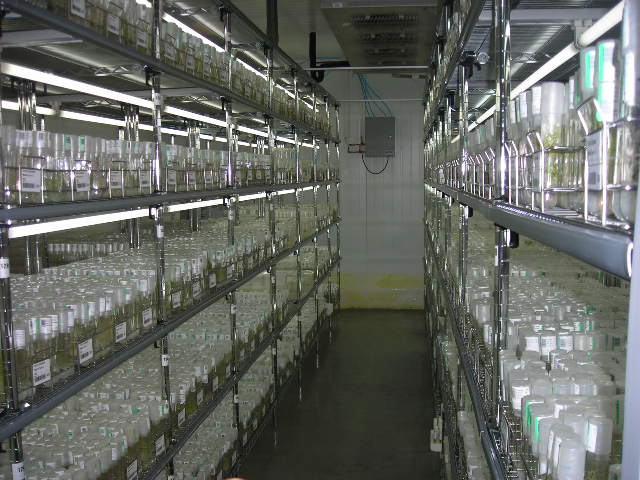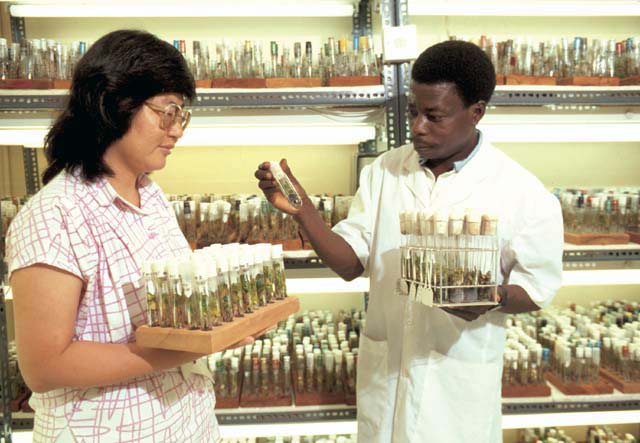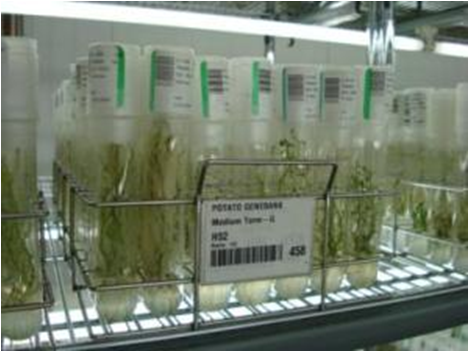In vitro bank
.jpg) View the guidelines on in vitro and field collection management by clicking on the icon above. (0.5 MB) |
Page compiled by: Bioversity International/ILRI, Addis Ababa, Ethiopia (Alexandra Jorge); ILRI, Addis Ababa, Ethiopia (Jean Hanson) including information extracted from: Reed BM, Engelmann F, Dulloo ME, Engels JMM. 2004. Technical guidelines for the management of field and in vitro germplasm collections. IPGRI Handbook for Genebanks No.7. IPGRI, Rome, Italy.
Tissue culture conservation
|
|
Seed storage is the preferred conservation method. However, it is not feasible for germplasm from clonal crops which are either vegetatively propagated and/or do not produce seeds, or for species with short lived recalcitrant seeds. For some genotypes, elite genetic combinations are only preserved through clonal means. Their conservation is dictated by breeding strategy as heterozygosity does not permit the maintenance of desired characteristics. Clonally propagated plants incur special needs for their conservation. Common options for storage include maintenance in field genebanks, and for species producing dormant vegetative propagules, conservation in cold stores (Reed, 2001) called vegetative banks. These approaches have limitations regarding efficiency, costs, security and long-term maintenance. In vitro conservation, which involves maintenance of explants in a sterile, pathogen-free environment is therefore preferentially applied to clonal crop germplasm and multiplication of species that produce recalcitrant seeds, or do not produce seeds. It also supports safe germplasm transfers under regulated phytosanitary control. This modern technique has already been applied for multiplication, storage and collection of germplasm of more than 1000 species.
|
|
Conservation in tissue culture in in vitro genebanks is often combined with cryopreservation. Cultures in the active genebank are maintained by successive subculturing allowing culture renewal and distribution. For medium term storage, sub-culture intervals are extended, reducing processing costs by arresting growth using cold treatments, adapted light conditions, culture medium modifications (osmotic active compounds, growth retardants). This increases efficient use of resources and staff time and offsets selection risks and contamination
|
|
Advantages
One of the major advantages of in vitro conservation of genetic resources is that tissue culture collections can be cleaned to provide a source of disease-free material. In vitro cultures are free of fungi and most bacteria while viruses can still be present. Therefore careful virus indexing procedures need to be applied to ensure material is disease free. Tissue culture storage also allows the conservation of germplasm in a protected environment, aseptic plant production, safe and easy international exchange of plant material and lower conservation costs. It is most appropriate for rapid multiplication purposes, dissemination and active collections.
Disadvantages
Maintaining material as shoot tip or meristem cultures, even when applying reduced growth conditions, remains labour intensive. It also involves the risk of losing valuable germplasm through accidental contamination of cultures and human error. Another major impediment of tissue culture storage under slow growth conditions is the possibility of genetic instability due to somaclonal variation (mutations that occur spontaneously in vivo or in vitro, whose frequency is generally increased during in vitro culture).
Practical considerations
Security
Security measures should be compliant with safety and ethical authorities regulations and guidelines, including observance of: (a) the Convention on Biological Diversity, (b) the Material Transfer Agreement, with respect to genetic resources exchange and (c) the International Plant Protection Convention. Security should ensure:
- Purity: freedom from contaminating organisms.
- Authenticity: correct identity.
- Stability: fit-for-purpose and trueness-to-type.
Good laboratory practices, application of aseptic techniques with careful containment strategies, clear and accurate documentation and avoiding practices that increase risks of genetic variation are all essential to ensure security of cultures.
Culture facilities
|
|
Research may be necessary to determine the appropriate environment to successfully culture and grow materials of different species in in vitro cultures. Some general guidelines are:
- Use culture growth rooms with temperature control, lighting and shelving.
- Aim for a room where the humidity is 40–50%. High humidity increases fungal growth, while low humidity dries cultures and creates dust problems.
- Use an isolated growth room for in vitro explants of materials taken directly from the field to allow time to detect insect infestations and prevent their spread to other cultures.
- Ensure a light intensity in the range from 10 to 1000 μmol S-1 m-2. Most plant cultures require 50–200 μmol S-1 m-2.
- Use ventilation systems or air-conditioning units to regulate temperature. Air should not flow directly onto the cultures. Common growth room temperatures range from 22ºC to 28ºC, depending on species requirements.
- Back-up generators are advisable for areas with frequent power cuts to control temperature and light.
Genetic stability during storage
Somaclonal variation, while a problem with plants regenerated from single cells, callus or adventitious buds, is not common in plants micropropagated from axillary buds. The frequency of somaclonal variation occurring, gross chromosomal aberrations and in vitro selection are enhanced in prolonged tissue culture. Exposure to minimal growth conditions over long periods of time can also be expected to lead to genetic change. It is significant that asexually propagated species for germplasm conservation may display a higher frequency of somaclonal variation as compared to those where the propagule is a seed. Great care should be taken to select culture practices to reduce this variation and ensure genetic integrity.
Preferred practices are:
- Avoid using germplasm propagated via dedifferentiated and adventitious routes for conservation.
-
Select germplasm from young cultures because somaclonal variation increases and totipotency decreases during prolonged culture.
Medium term storage using slow growth
The objective of slow growth (or minimal growth) is to reduce the sub-culture interval to a critical level which does not impose a long-term deleterious effect on the germplasm, or the stability of regenerated/regrown plants. However, slow growth treatments incur some level of stress and it is essential to optimise regimes for each species for timing of sub-culture and regeneration. Minimal growth storage is achieved via several treatments, applied singularly or in combination:
-
Physical growth limitation
- Low temperature
- Low light/restricted photoperiod
- Minimal containment
- Minimal O2
- Osmotic (water) stress
-
Chemical growth limitation
- Growth regulator retardation
- Growth inhibitors
-
Minimal nutrition
- Low macro nutrient levels
- Low micro nutrients levels
Choice of treatment is largely species-dependent and dictated by the ability of specific cultures to withstand the stresses incurred.
Culture and storage protocols have been developed for several important vegetatively propagated crops, including banana, cassava, potato, sweet potato, yam.
Banana - http://cropgenebank.sgrp.cgiar.org/index.php?option=com_content&view=article&id=545&Itemid=740&lang=english
Cassava - http://webapp.ciat.cgiar.org/asia_cassava/pdf/proceedings_workshop_02/136.pdf
Potato - http://www.cipotato.org/csd/Materials/Tissue/Capitulo4.pdf
Sweet potato - http://www.cipotato.org/csd/materials/Sweetpotato%202-4.asp
Yam - http://www.ejbiotechnology.info/content/vol1/issue3/full/2/bip/
References and further reading
Ashmore SW, Engelmann F, editors. 1997. Status report on the development and application of in vitro techniques for the conservation and use of plant genetic resources. International Board for Plant Genetic Resources, Rome (Italy). 67 p.
Batugal PA, Engelmann F, editors. 1998. Coconut embryo in vitro culture. Proceedings of the First Workshop on Embryo Culture, 27-31 October 1997, Banao, Guinobatan, Albay, Philippines. 164 p. Available from: http://www2.bioversityinternational.org/publications/Web_version/363 Date accessed 20 April 2011.
Benson EE, Harding K, Debouck D, Dumet D, Escobar R, Mafla G, Panis B, Panta A, Tay D, Van den houwe I, Roux N. 2011. Refinement and standardization of storage procedures for clonal crops - Global Public Goods Phase 2: Part I. Project landscape and general status of clonal crop in vitro conservation technologies. System-wide Genetic Resources Programme, Rome, Italy. Available here (2.5 MB).
Benson EE, Harding K, Debouck D, Dumet D, Escobar R, Mafla G, Panis B, Panta A, Tay D, Van den houwe I, Roux N. 2011. Refinement and standardization of storage procedures for clonal crops - Global Public Goods Phase 2: Part II. Status of in vitro conservation technologies for: Andean root and tuber crops, cassava, Musa, potato, sweet potato and yam. System-wide Genetic Resources Programme, Rome, Italy. Available as full size PDF (9 MB) and light version (3.5 MB).
Benson EE, Harding K, Debouck D, Dumet D, Escobar R, Mafla G, Panis B, Panta A, Tay D, Van den houwe I, Roux N. 2011. Refinement and standardization of storage procedures for clonal crops - Global Public Goods Phase 2: Part III. Multi-crop guidelines for developing in vitro conservation best practices for clonal crops. System-wide Genetic Resources Programme, Rome, Italy. Available here (4.5 MB).
Chandel KPS, Pandey R, Paroda RS, Arora RK. 1991. Plant genetic resources conservation: recent approaches. Plant genetic resources: conservation and management. Concepts and approaches. International Board for Plant Genetic Resources New Delhi (India. p. 247-272.
Chaudhury R, Pandey R, Malik SK, Bhag Mal, editors. 2003. In vitro conservation and cryopreservation of tropical fruit species. Proceedings of the Regional Training Course on In Vitro Conservation of Tropical Fruit Genetic Resources, organized at the National Bureau of Plant Genetic Resources (NBPGR), New Delhi, India, 4-16 February 2002. New Delhi (India): IPGRI/NBPGR. 293 p.
Debergh PC, Zimmerman RH, editors. 1991. Micropropagation Technology and Application. Kluwer Academic, Dordrecht, The Netherlands.
Engelmann F, Batugal P, Oliver J, editors. 2002. Coconut embryo In vitro culture: Part II. 2nd International Coconut In vitro Culture Workshop, Merida, Mexico, 14-17 March 2000.
Engels JMM, Visser L, editors. 2003. A guide to effective management of germplasm collections. IPGRI Handbooks for Genebanks No. 6. IPGRI, Rome, Italy. Available in English (1.4 MB) and Spanish (1.5 MB).
FAO. 2013. Genebank standards for plant genetic resources for food and agriculture. Food and Agriculture Organization of the United Nations, Rome. Available in English, Spanish, French, Arabic, Russian and Chinese here.
Frison EA. 1988. IBPGR's (International Board for Plant Genetic Resources) interests and needs for pathogen testing of germplasm. Conservation and movement of vegetatively propagated germplasm: In vitro culture and disease aspects. Report of a subcommittee meeting. International Board for Plant Genetic Resources. Advisory Committee on In Vitro Storage. Rome (Italy. p. 15-16.
Fuentealba A, Contreras M A, Esquinas-Alcazar JT. 1987. Tecnicas de cultivo in vitro para conservacion de germoplasma. Anales. Simposio "Recursos Fitogeneticos" Valdivia (Chile): UACH/IBPGR. p. 174-177.
George EF. 1993. Plant Propagation by Tissue Culture—Part 1. Exegetics Limited, UK.
George EF. 1996. Plant Propagation by Tissue Culture—Part 2. Exegetics Limited, UK.
IBPGR. 1988. Conservation and movement of vegetatively propagated germplasm: In vitro culture and disease aspects. Report of a subcommittee meeting. International Board for Plant Genetic Resources. Advisory Committee on In Vitro Storage Rome (Italy). 63 p.
Iwanaga M. 1994. Cassava genetic resources management at CIAT International network for cassava genetic resources. Report of the first meeting of the International Network for Cassava Genetic Resources held at CIAT, Cali, Colombia, 18-22 August 1992 International Crop Network Series (IPGRI) no. 10. Rome (Italy). p. 77-86.
Kyte LA, Kleyn J. 2001. Plants from Test Tubes. An Introduction to Micropropagation (3rd edn). Timber Press, Portland, Oregon, USA.
Mafla G, Roa JC, Aranzales E, Debouck D. 2009. Handbook of procedures for in vitro germplasm conservation of the genus Manihot. CIAT, Cali, Colombia. 56 pp. Available here (8 MB).
Malaurie B, Pungu O, Dumont R, Trouslot MF. 1993. The creation of an in vitro germplasm collection of yam (Dioscorea spp.) for genetic resources preservation. Euphytica65:113–122.
Mandal BB. 1997. Application of in vitro/cryopreservation techniques in conservation of horticultural crop germplasm. Acta Hort. (ISHS) 447:483-490.
Ng SYC. 1992. Micropropagation of white yam (Dioscorea rotundata Poir.). Pp. 135–159 in Biotechnology in Agriculture and Forestry, Vol. 19, High-Tech and Micropropagation III (Y.P.S. Bajaj, ed.). Springer, Berlin, Germany.
Ng SYC. 1994. Production and distribution of virus-free yam (Dioscorea rotundata Poir.). Acta Horticult. 380:324–328.
Parra Quijano M, Nustez C, Reyes LM. 2005. [Collection and conservation of ulluco (Ullucus tuberosus Caldas) in Colombia]. Colecta y conservacion de ulluco (Ullucus tuberosus Caldas) en Colombia. Plant Genetic Resources Newsletter (IPGRI/FAO) no. 142: 63-67. Available from: http://www2.bioversityinternational.org/publications/pgrnewsletter/article.asp?lang=en&id_article=10&id_issue=142 Date accessed 20 April 2011
Reed BM. 1990. Multiplication of Rubus germplasm in vitro: A screen of 256 accessions. Fruit Varieties J. 44:141–148.
Reed BM. 1991. Application of gas-permeable bags for in vitro cold storage of strawberry germplasm. Plant Cell Reports 10:431-434.
Reed BM. 1992. Cold storage of strawberries in vitro: A comparison of three storage systems. Fruit varieties journal 46:98-102.
Reed BM. 2001. Implementing cryogenic storage of clonally propagated plants. Cryoletters 22:97-104.
Reed BM, Engelmann F, Dulloo ME, Engels JMM. 2004. Technical guidelines for the management of field and in vitro germplasm collections. IPGRI Handbook for Genebanks No.7. IPGRI, Rome, Italy. Available here.
Reed BM, Paynter C, Bartlett B. 2002. Shipping procedures for plant tissue cultures. USDA-ARS-NCGR. Available from: http://www.ars-grin.gov/cor/presentations/shipping2001/sld001.htm. Date acchessed: 24 March 2010.
Reed BM, Chang Y. 1997 Medium and long term storage of in vitro cultures of temperate fruit and nut crops. In
Conservation of Plant Genetic Resources In Vitro (M.K. Razdan, ed.). Oxford and IBH Publishing, India.
Reed BM. Stalker HT, Chapman C. 1989. In vitro conservation of germplasm. Scientific management of germplasm: characterization, evaluation and enhancement. IBPGR Training Courses: Lecture Series (IBPGR) no. 2. Rome (Italy. p. 23-30.
Reed BM, Tanprasert P. 1995. Detection and control of bacterial contaminants of plant tissue cultures. A review of recent literature. Plant Tissue Cult. Biotechnol. 1:137–142.
Thorpe TA, editor. 1981. Plant Tissue Culture Methods and Applications in Agriculture (1st edn). Academic Press, New York, USA.
Van den Houwe I, De Smet K, Tezenas du Montcel H, Swennen R. 1995. Variability in storage potential of banana shoot cultures under medium term storage conditions. Plant Cell, Tissue Organ Cult. 42:269–274.
Withers LA. 1988. The current status of in vitro culture for the international movement of plant germplasm. Conservation and movement of vegetatively propagated germplasm: In vitro culture and disease aspects. Report of a subcommittee meeting. International Board for Plant Genetic Resources. Advisory Committee on In Vitro Storage. p. 47-60.
Withers LA, Paroda RS, Arora RK. 1991. Biotechnology and plant genetic resources conservation. Plant genetic resources: conservation and management. Concepts and approaches. International Board for Plant Genetic Resources, New Delhi (India). p. 273-297.
Comments
- No comments found









Leave your comments
Post comment as a guest